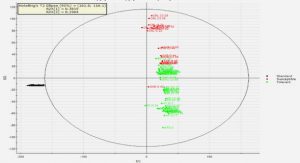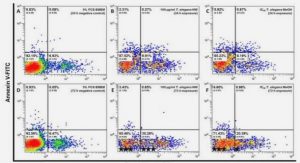Get Complete Project Material File(s) Now! »
Chapter 2. Materials and methods
Chemicals and reagents
Oxaliplatin was obtained from Sanofi (Paris, France) and Sigma-Aldrich (St Louis, MO, USA). Cisplatin and carboplatin were obtained from Sigma-Aldrich. The racemic mixture of ormaplatin was kindly provided by the National Cancer Institute (Bethesda, MD, USA). R,R-ormaplatin, S,S-ormaplatin, R,R-Pt(DACH)Cl2 and S,S-Pt(DACH)Cl2 were synthesized as outlined previously (Screnci et al., 1997). Sodium thiosulfate pentahydrate was purchased from Scharlau (Barcelona, Spain). Cimetidine, actinomycin D, tetraethylammonium chloride (TEA), potassium chloride, 4,4’-diisothiocyanatostilbene-2,2’-disulfonic acid disodium salt hydrate (DIDS), 5-nitro-2-(3-phenylpropylamino)benzoic acid (NPPB) and benzamide were purchased from Sigma-Aldrich. Wortmannin, NU 7026 and olaparib were purchased from Cayman Chemical (Ann Arbor, MI, USA). Both 5% glucose and 0.9% sodium chloride were obtained from Baxter (Deerfield, IL, USA).
Animals
Animals were housed by the Vernon Jansen Unit at the University of Auckland, and were maintained in a temperature-controlled environment on a 12-hour light-dark cycle with access to food and water ad libitum. All animal procedures were approved by and performed in compliance with ethical guidelines of the Animal Ethics Committee of the University of Auckland.
Cell culture
Primary culture of rat dorsal root ganglion (DRG) cells was established as described previously with slight modifications (Jong et al., 2011, Liu et al., 2013). In brief, DRGs from all spinal levels were dissected from 20-day-old Wistar rats euthanized with pentobarbitone (Chemstock Animal Health, Christchurch, New Zealand). Then, DRGs were digested with 2.5 mg/ml collagenase and 1 mg/ml dispase (Life Technologies, Carlsbad, CA, USA) for 50 min at 37°C, followed by trypsinization using 0.25% trypsin (Life Technologies) for 40 min at 37°C. Subsequently, DRGs were mechanically triturated using fine-bore glass Pasteur pipettes to dissociate and release cells, and the resulting cell suspension was filtered through a 100-µm cell strainer (Becton Dickinson, Franklin Lakes, NJ, USA) to remove tissue debris. DRG cells were isolated by centrifugation at 800 × g in Percoll solution (density: 1.040 g/ml) (Sigma-Aldrich) for 20 min at room temperature. Then, DRG cells were re-suspended and cultured in Neurobasal-A medium supplemented with 5% horse serum, 100 U/ml penicillin, 0.1 mg/ml streptomycin, 2 mM glutamine and 1% N-2 supplement (Life Technologies) at 37°C in a humid atmosphere of 5% CO2-95% air. For the first two days of culture, 40 µM 5-fluoro-2’-deoxyuridine and 120 µM uridine (Sigma-Aldrich) were added to remove non-neuronal cells. Then, DRG cells were cultured in the normal culture medium for a further one day before any experimental manipulation.
Cultured DRG cells consisted of sensory neurons and non-neuronal cells that were easily distinguishable by their morphology under phase-contrast microscopy (Figure 2.1). Typically, DRG neurons were characterized by their large and round cell bodies with a sharp halo, whereas non-neuronal cells showed small and spindle-shaped morphology. This observation Rat DRG cells grown in culture for three days were photographed from the same field of view before (A) and after neurofilament heavy subunit (NF-H, green) fluorescence immunocytochemistry (B-E). Nuclear DNA was counterstained with DAPI (blue). Images were acquired using a 10x objective.
Images show that cultured rat DRG cells consisted of sensory neurons and non-neuronal cells that were easily distinguishable by their morphology under phase-contrast microscopy and by immunocytochemistry using a neuronal marker, NF-H. was confirmed by immunocytochemistry using a neuronal marker, neurofilament heavy subunit.
Fluorescent immunocytochemistry
Rat DRG cells grown on chamber slides were washed with pre-warmed phosphate buffered saline (PBS), fixed with 4% paraformaldehyde for 15 min at room temperature, and then permeabilized using 0.2% Triton X-100 in PBS for 15 min at room temperature. Next, cells were incubated with blocking solution (PBS containing 0.2% Triton X-100, 3% goat serum and 2% bovine serum albumin) for 60 min at room temperature. After rinsing with 0.2% Triton X-100 in PBS, cells were incubated with Anti-Neurofilament 200 (NF-H) primary antibody (1:800, Sigma-Aldrich) diluted in immunobuffer (PBS containing 0.2% Triton X-100 and 1% goat serum) for overnight at 4°C in darkness. Subsequently, cells were rinsed with 0.2% Triton X-100 in PBS, and were incubated with Alexa Fluor 488-labelled anti-rabbit IgG secondary antibody (1:500, Life Technologies) diluted in immunobuffer for 3 h at 4°C, protected from light. After incubation, cells were washed with PBS and then counterstained and coverslipped with VECTASHIELD mounting medium containing 4’,6-diamidino-2-phenylindole (DAPI) (Vector Laboratories, Burlingame, CA, USA). Fluorescence images were acquired using a Nikon Eclipse Ti-U inverted microscope equipped with a Nikon DS-Fi1c digital camera (Nikon, Tokyo, Japan), at 465-495 nm excitation and 515-555 nm emission for NF-H staining and at 330-380 nm excitation and >420 nm emission for DAPI staining.
Experimental incubation
In most experiments, rat DRG cells grown on plates or chamber slides were exposed to experimental conditions either for 3 h followed by culture in drug-free medium until up to 48 h after the start of treatment, or continuously for up to 48 h, as indicated in each chapter.
To investigate the effects of DNA-PK and PARP-1 inhibitors on oxaliplatin toxicity in Chapter 5, rat DRG cells were pre-treated with these inhibitors for 1 h before exposure to oxaliplatin for 3 h, followed by culture in drug-free medium until 24 h.
Assessment of nascent RNA synthesis by 5-ethynyl uridine incorporation
A Click-iT RNA Imaging Kit (Life Technologies) was used according to manufacturer’s instructions with slight modifications. In brief, 20 h before the end of the experiment, 1 mM 5-ethynyl uridine (EU) was added to the cells grown on chamber slides. At the end of the experiment, cells were washed with pre-warmed PBS, fixed with 4% paraformaldehyde for 15 min at room temperature, and then permeabilized using 0.2% Triton X-100 in PBS for 15 min at room temperature. To detect RNA-incorporated EU using a click chemistry reaction with Alexa Fluor 594-labelled azide, cells were then incubated with Click-iT reaction cocktail for 30 min at room temperature, protected from light. After incubation, cells were washed with Click-iT reaction rinse buffer and PBS, and then counterstained and coverslipped with VECTASHIELD mounting medium containing DAPI (Vector Laboratories).
Fluorescence images were acquired using a Nikon Eclipse Ti-U inverted microscope equipped with a Nikon DS-Fi1c digital camera (Nikon), at 540-580 nm excitation and 600-660 nm emission for Alexa594 labelling of RNA-incorporated EU and at 330-380 nm excitation and >420 nm emission for DAPI staining of nuclear DNA. After background correction, the fluorescence pixel intensities of EU-Alexa594 staining within cell bodies and DAPI staining within nuclei were measured for individual neurons using Nikon NIS-Elements software (Nikon). The same individual neurons were also measured for cell body areas as described in section 2.10.
Assessment of nascent RNA synthesis by [3H]uridine incorporation
One hour before the end of the experiment, 5 µCi/ml [5-3H]urdine (sp. act. >20 Ci/mmol, PerkinElmer, Waltham, MA, USA) was added to the culture. At the end of the experiment, labelling medium was removed and cells were re-suspended using 0.25% trypsin (Life Technologies). The cell suspension was thoroughly mixed with ice-cold 10% (w/v) trichloroacetic acid (Sigma-Aldrich) and placed on ice for 30 min. The acid-precipitable material was collected on a GF/C glass-fibre filtermat (Filtermat A, PerkinElmer) by a plate harvester (Harvester 96, Tomtec, Hamden, CT, USA). The filtermats were dried at room temperature overnight and their radioactivity was measured in a scintillation cocktail (Betaplate Scint, PerkinElmer) by a liquid scintillation counter (Wallac 1450 MicroBeta JET, PerkinElmer).
Assessment of platinum binding to DNA
Following experimental incubations, DRG cells were harvested and their genomic DNA was extracted using a Wizard Genomic DNA Purification Kit (Promega, Madison, WI, USA) according to the manufacturer’s instructions, with the modification that isopropanol precipitation was performed at 4°C overnight. The DNA content was determined by measuring the absorbance at 260 nm with a NanoDrop ND-1000 spectrophotometer (Thermo Fisher Scientific, Waltham, MA, USA). Subsequently, DNA samples were digested with an equal volume of 70% nitric acid at room temperature overnight and then at 95°C for 2 h. The resulting digests were diluted in Milli-Q water spiked with 50 ppb thallium (SPEX CertiPrep, Metuchen, NJ, USA) as internal standard. The platinum content was quantitated by inductively coupled plasma mass spectrometry (ICP-MS) on a Varian 820-MS (Varian, Palo Alto, CA, USA) using a standard calibration method. The final platinum content was normalized to the DNA content.
CHAPTER 1. GENERAL INTRODUCTION
1.1. Platinum-based anticancer drugs
1.1.1. Clinical applications and toxicities
1.1.2. Mechanism of action
1.2. Platinum drug-induced peripheral neurotoxicity
1.2.1. Clinical features
1.2.2. Mechanisms
1.3. Platinum drug-induced transcriptional inhibition
1.3.1. Evidence
1.3.2. Mechanisms
1.4. Summary and aims of thesis
CHAPTER 2. MATERIALS AND METHODS
2.1. Chemicals and reagents
2.2. Animals
2.3. Cell culture
2.4. Fluorescent immunocytochemistry
2.5. Experimental incubation
2.6. Assessment of nascent RNA synthesis by 5-ethynyl uridine incorporation
2.7. Assessment of nascent RNA synthesis by [3H]uridine incorporation
2.8. Assessment of platinum binding to DNA
2.9. Measurement of total RNA content
2.10. Measurement of neuronal cell body size and number
2.11. Apoptosis assay
2.12. Statistical analysis
CHAPTER 3. VISUALIZATION OF NASCENT RNA SYNTHESIS IN CULTURED RAT DRG NEURONS VIA A CLICK CHEMISTRY REACTION LABELLING TECHNIQUE
3.1. Introduction
3.2. Results
3.2.1. Optimization of 5-ethynyl uridine exposure
3.2.2. Visualization of nascent RNA synthesis
3.2.3. Quantitation of nascent RNA synthesis, DNA content and cell body size
3.2.4. Correlation between the level of nascent RNA synthesis and cell body size
3.2.5. Effects of oxaliplatin
3.3. Discussion
CHAPTER 4. TIME-COURSE STUDIES OF OXALIPLATIN EFFECTS IN CULTURED RAT DRG CELLS
4.1. Introduction
4.2. Results
4.2.1. Platinum binding to DNA
4.2.2. Inhibition of nascent RNA synthesis
4.2.3. Depletion of total RNA content
4.2.4. Neuronal cell body atrophy
4.2.5. Temporal interrelationships between oxaliplatin effects
4.2.6. Number of neurons
4.2.7. Apoptosis assay
4.2.8. Effects of actinomycin D on neuronal cell body size
4.3. Discussion
CHAPTER 5. EFFECTS OF INHIBITORS ON OXALIPLATIN TOXICITY IN CULTURED RAT DRG CELLS
5.1. Introduction
5.2. Results
5.2.1. Sodium thiosulfate
5.2.2. Cimetidine
5.2.3. DNA-dependent protein kinase (DNA-PK) inhibition
5.2.4. Poly(ADP-ribose) polymerase 1 (PARP-1) inhibition
5.2.5. K+ channel blockade
5.2.6. Cl- channel blockade
5.3. Discussion
CHAPTER 6. COMPARATIVE EFFECTS OF DIFFERENT PLATINUM DRUGS ON CULTURED RAT DRG CELLS
6.1. Introduction
6.2. Results
6.2.1. Platinum-based anticancer drugs
6.2.2. Enantiomers of diaminocyclohexane platinum-based compounds
6.3. Discussion
CHAPTER 7. GENERAL DISCUSSION
7.1. Platinum-DNA damage
7.2. Transcriptional inhibition
7.3. Neuronal cell body atrophy and peripheral neurotoxicity
7.4. Future directions
7.5. Conclusions
LIST OF REFERENCES
GET THE COMPLETE PROJECT






